Flatpak is a universal package management utility that is written in C. It allows different users to install and run software in an isolated environment. This utility behaves like a snap application, used for simplifying the software packages management across various operating distributions also used for deployment and virtualization. Flatpak can install on almost every type of Linux distribution.
Here at Ibmi Media, as part of our Server Management Services, we regularly help our Customers to perform related Software Installation queries on CentOS systems.
In this context, we shall look into how to install Flatpak on CentOS 8 system.
How to Install Flatpak on CentOS ?
Before performing this Installation procedure, ensure that you are using a user with root user or have privileges to run sudo commands.
Flatpak can be directly installed from the official CentOS 8 repository using the dnf package manager. To begin, Open the command-line tool 'Terminal' by clicking on the application icon and then follow the steps outlined below.
1. Update repository and install Flatpak
First, update the package repository and then use the following command to install Flatpak on your system:
$ sudo dnf update
$ sudo dnf install FlatpakNow, enter the administrative password. After that, Flatpak installation will begin on your system. During the installation, the user confirmation prompt will display on the terminal. Enter 'y' and then press the 'Enter' key to continue the installation.
Then you will see the complete status on the terminal window that means an installation of flatpak is completed now.
2. Check Flatpak version
Check the installed Flatpak details on your system. The simple and easiest command to display the installed application information is given below:
$ rpm -qi package-name
$ rpm -qi flatpakHow to Uninstall Flatpak from CentOS 8 ?
Flatpak utility can be easily uninstalled from your system by running the following command:
$ sudo dnf remove flatpak[Need help in Installing Open Source Software on Debian System ? We can help you. ]
Conclusion
This article covers the installation steps of Flatpak on the CentOS 8 system. With Flatpak, users can easily install new packages or applications from the flathub repository in an isolated space.
Flatpak is a package management system that aims to enable users and developers to install and manage software packages on Linux systems regardless of the Linux distribution, runtime, dependencies and the type of package management. A flatpak application runs in a sandboxed environment. This is an isolated environment that is bundled with all the dependencies, libraries and everything that is needed for the app to run smoothly.
How to Enable Flatpak in Red Hat / CentOS / Fedora ?
For RedHat / CentOS 8 and Fedora 22 and later versions, invoke the command below to enable flatpak:
$ sudo dnf install flatpakFor earlier versions of Red Hat and CentOS use the YUM package manager:
$ sudo yum install flatpak
This article covers the installation steps of Flatpak on the CentOS 8 system. With Flatpak, users can easily install new packages or applications from the flathub repository in an isolated space.
Flatpak is a package management system that aims to enable users and developers to install and manage software packages on Linux systems regardless of the Linux distribution, runtime, dependencies and the type of package management. A flatpak application runs in a sandboxed environment. This is an isolated environment that is bundled with all the dependencies, libraries and everything that is needed for the app to run smoothly.
How to Enable Flatpak in Red Hat / CentOS / Fedora ?
For RedHat / CentOS 8 and Fedora 22 and later versions, invoke the command below to enable flatpak:
$ sudo dnf install flatpakFor earlier versions of Red Hat and CentOS use the YUM package manager:
$ sudo yum install flatpak














